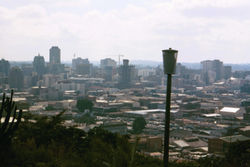Harare
2007 Schools Wikipedia Selection. Related subjects: African Geography
| Harare, Zimbabwe | |
| Harare, Zimbabwe | |
|
Image:Zimbabwe Provinces Haprare 250px.png Map of Zimbabwe showing the location of Harare. |
|
| Coordinates: | |
|---|---|
| Province | Harare |
| Area | |
| - City | km² |
| Population | |
| - City (2006) | 2,800,111 |
| - Urban | 1,600,000 |
| estimated | |
| Time zone | CET ( UTC+1) |
| - Summer ( DST) | CEST ( UTC+1) |
Harare ( pronounced /'hʌ ɹɑ' ɹi/, formerly Salisbury) is the capital city of Zimbabwe. It has an estimated population 1,600,000, with 2,800,000 in its metropolitan area (2006). It is Zimbabwe's largest city and its administrative, commercial, and communications centre. It is a trade centre for tobacco, maize, cotton, and citrus fruits. Manufactures include textiles, steel, and chemicals. Gold is mined in the area.. It is at an elevation of 4,865 feet (1,483 metres) and has a temperate climate.
Despite the renaming of the city, some suburbs have retained their European names, such as Warren Park 'D', Borrowdale, Mount Pleasant, Tynwald and Avondale.
Harare is famous for its beautiful jacaranda-lined streets, especially in the "Avenues" suburbs to the immediate north of the city centre.
Harare is the site of the University of Zimbabwe, the largest and most complete institution of higher learning in Zimbabwe.
History
The city was founded in 1890 as a fort by the Pioneer Column, a mercenary force organized by Cecil Rhodes. The city was originally named Salisbury after the 3rd Marquess of Salisbury, then British prime minister. It became a city in 1935. Salisbury was the capital of the Federation of Rhodesia and Nyasaland from 1953 to 1963.
The name of the city was changed to Harare on April 18th, 1982, the second anniversary of Zimbabwean independence, taking its name from the Shona chieftain Neharawa.
In the early 21st century Harare has been adversely affected by the political and economic crisis that is currently plaguing Zimbabwe, after the contested 2002 Presidential election and 2005 parliamentary elections. The elected council was replaced by a government appointed commission for alleged inefficiency, but essential services such as rubbish collection and street repairs have rapidly worsened, and are now virtually non-existent. In May 2006 the Zimbabwean newspaper the Financial Gazette, described the city in an editorial as a "sunshine city-turned-sewage farm."
In May 2005 the Zimbabwean government demolished shantytowns in Harare and the other cities in the country in Operation Murambatsvina (Operation "Drive Out Trash"). This caused a sharp reaction in the international community because it took place without prior warning and no advance plans were made to provide alternative housing. It was widely alleged that the true purpose of the campaign was to punish the urban poor for supporting the opposition Movement for Democratic Change and to reduce the likelihood of mass action against the government by driving people out of the cities. The government claimed it was necessitated by a rise of criminality and disease. This was followed by Operation Garikayi (Operation "Better Living") a year later which consisted of building inadequate concrete shacks with no electricity, plumbing or other infrastructure in inaccessible areas.
Sister Cities
 Nottingham, UK
Nottingham, UK Munich, Germany
Munich, Germany Cincinnati, United States
Cincinnati, United States Buxton, UK
Buxton, UK Prato, Italy
Prato, Italy Lago, Italy
Lago, Italy




